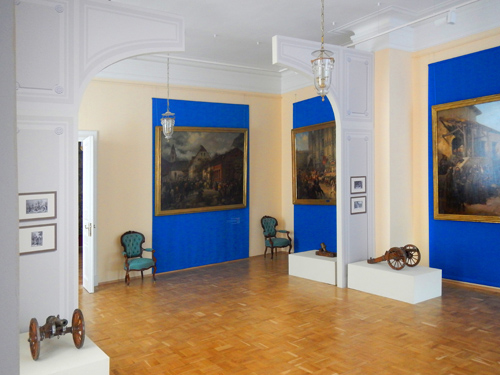Arsenal Hall

The reconstruction of the Gatchina Palace in 1850 under Nicholas I involved rebuilding both side wings, which were dismantled first and then raised anew, their hight being significantly increased. The newly built Arsenal Wing had over 200 rooms intended for various purposes.
The largest hall known as the Arsenal was on the ground floor. Throughout its history from the 18th century onwards, it was the focal point around which social and family life revolved. It took on its final appearance during the reign of Nicholas I. This was the venue for Sunday and gala dinners, during which music was played. The walls were decorated with watercolors by M. Zichi, some of which had handwritten inscriptions by Alexander III noting who was depicted. There were also many artworks, a stage for a domestic theatre, a children’s wooden slide, and swings shaped as a boat.
The most valuable artworks from the hall’s interior decoration were preserved during the war. Among the most significant are three paintings by A.I. Charlemagne, on view in the exhibition, watercolors and drawings by the court painter M.A. Zichi (now at Pavlovsk and Peterhof museums), and fine examples of animal sculpture (now at the Tsarskoye Selo museum). The surviving chairs and arm-chairs make it possible to recreate the furniture of the hall.
See on interactive plan

The reconstruction of the Gatchina Palace in 1850 under Nicholas I involved rebuilding both side wings, which were dismantled first and then raised anew, their hight being significantly increased. The newly built Arsenal Wing had over 200 rooms intended for various purposes.
The largest hall known as the Arsenal was on the ground floor. Throughout its history from the 18th century onwards, it was the focal point around which social and family life revolved. It took on its final appearance during the reign of Nicholas I. This was the venue for Sunday and gala dinners, during which music was played. The walls were decorated with watercolors by M. Zichi, some of which had handwritten inscriptions by Alexander III noting who was depicted. There were also many artworks, a stage for a domestic theatre, a children’s wooden slide, and swings shaped as a boat.
The most valuable artworks from the hall’s interior decoration were preserved during the war. Among the most significant are three paintings by A.I. Charlemagne, on view in the exhibition, watercolors and drawings by the court painter M.A. Zichi (now at Pavlovsk and Peterhof museums), and fine examples of animal sculpture (now at the Tsarskoye Selo museum). The surviving chairs and arm-chairs make it possible to recreate the furniture of the hall.
See on interactive plan
